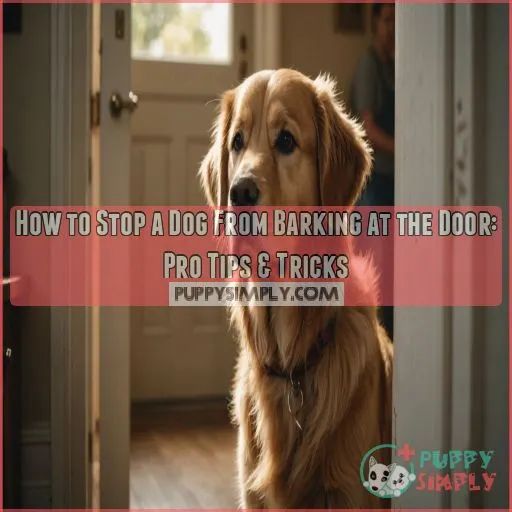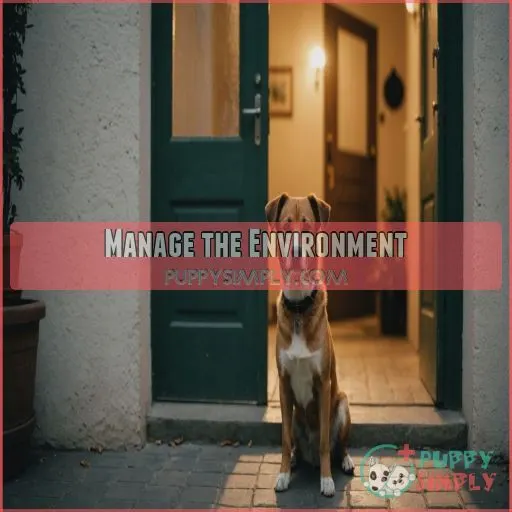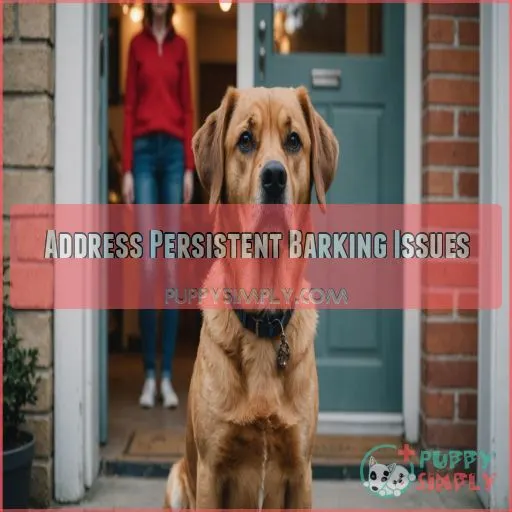This site is supported by our readers. We may earn a commission, at no cost to you, if you purchase through links.
 Tired of your dog barking up a storm every time the doorbell rings? You’re not alone! But don’t worry, we’ve got your back.
Tired of your dog barking up a storm every time the doorbell rings? You’re not alone! But don’t worry, we’ve got your back.
First, figure out what’s triggering the barking – is it separation anxiety, fear, or just plain boredom?
Once you know the root cause, you can start training your pup to stay calm.
Teach the "quiet" command, reward good behavior, and gradually expose them to visitors.
You can also manage the environment by blocking their view of the door and using white noise to mask outside sounds.
With a little patience and consistency, you’ll have a well-behaved, non-barking dog in no time. Ready to get started?
Table Of Contents
Key Takeaways
- Identify the root cause of the barking – is it separation anxiety, fear, or boredom? Understanding the trigger is the first step to finding a solution.
- Train your pup with the "quiet" command and reward calm behavior. Consistency is key, so get the whole family on board with the training.
- Manage your dog’s environment by blocking their view of the door and using white noise to mask outside sounds. This can help reduce their barking triggers.
- Be patient and persistent with your training. Stopping excessive door barking takes time, but with Positive reinforcement and gradual exposure, you’ll have a well-behaved pup in no time.
Identify the Root Cause
You’ve just sat down with your favorite show when the doorbell rings, and the barking begins—again.
To stop it, you’ll need to understand why your furry friend feels the need to alert the neighborhood every time the doorbell goes off.
Separation Anxiety and Barking
Separation anxiety could have your dog singing the blues every time you leave.
Understanding this causes barking is key.
Try calming techniques like crate training for a safe haven or hire a dog walker for a midday break.
If all else fails, consult your vet about anxiety medication.
With patience and understanding, you’ll help your furry friend feel more secure.
Fear and Territorial Barking
Your dog may bark at the door out of fear or a desire to protect their territory.
To address this, try these tips:
- Identify your dog’s triggers and slowly desensitize them.
- Create a "safe space" where they can retreat when feeling anxious.
- Use calming pheromones to help your pup feel more relaxed.
- Teach them the "quiet" command and reward calm behavior.
Boredom and Attention-Seeking Barking
Ever notice your dog barking up a storm by the door for no reason [and wonder if they ever get tired of barking](https://puppysimply.com/do-dogs-get-tired-of-barking/)??
Sometimes that’s a classic, "Hey, I’m bored, pay attention to me!"
Dogs love games, toys, and a good routine.
Mixing up their playtime routine or introducing new toys can be the secret sauce.
Keep ’em busy, and the barking might just take a backseat.
Medical Issues and Barking
Sometimes, barking is a cry for help.
If your dog suddenly sounds like it’s auditioning for a canine opera, it might have hidden issues like ear infections, thyroid problems, or even dental pain.
Allergies can tickle their senses too.
A quick vet visit can be your best detective to keep Fido happy, healthy, and away from doorbell frenzies.
Lack of Training and Barking
When Sparky’s barking up a storm, lack of training might be the culprit. Understanding dog training basics can help. Early socialization and consistent commands prevent chaotic door greetings.
- Use positive reinforcement for calm behavior.
- Identify barking triggers early.
- Keep commands short and consistent.
- Regular practice strengthens obedience.
You’ll soon see a heavenly hush!
Train Your Dog to Remain Calm
Training your dog to remain calm when someone is at the door is key to curbing excessive barking.
By desensitizing your pup to doorbell triggers, teaching the "quiet" command, and rewarding good behavior, you can transform your canine companion into a well-mannered greeter.
Desensitize Your Dog to the Doorbell
To tackle doorbell anxiety, try gradual exposure.
Ring the doorbell softly at first and reward your pup with a treat if they stay calm.
By using positive reinforcement, you’re letting them know the doorbell isn’t a big, scary monster.
Sprinkle in calming cues to ease nerves—just like adding sprinkles on a cupcake, it makes everything better!
Teach the Quiet Command
After desensitizing your dog to the doorbell, it’s time to teach the "quiet" command.
Timing’s everything here! Use a calm voice and a hand signal to reinforce it.
When your dog stops barking, gently praise and reward him.
Consistency’s the name of the game, my friend! Practice regularly and watch your dog’s barking melt like butter.
Practice Stay and Wait Commands
Practicing stay and wait commands can transform your dog’s antics at the door into a scene from a well-rehearsed play.
Picture your star, the dog, sitting patiently, awaiting your cue.
It’s all about consistency and rewarding patience.
Keep distractions minimal, reinforce with warm praise, and soon, door chaos becomes an Oscar-worthy tale of canine calm.
Reward Good Behavior and Ignore Bad
Consistency is key when rewarding good behavior and ignoring bad. Reward your pup with treats, praise, or playtime when they remain calm and quiet.
Timing is everything – reward the instant they stop barking, not after.
Ignoring the barking, no matter how tempting, will teach them that it doesn’t get them the attention they crave.
Gradually Increase Exposure to Visitors
Now that you’ve got the hang of rewarding good behavior, it’s time for the next challenge—ramping up visitor introductions.
Start small with gradual steps.
Invite friends over, one by one.
Use positive reinforcement and desensitization techniques as your secret sauce.
Before you know it, your pup will greet guests with a tail wag instead of a barkfest!
Manage the Environment
Creating a peaceful environment can work wonders in minimizing your dog’s door-related barking.
By masking sounds and offering distractions, you’re basically making your home the doggie version of a zen retreat—minus the yoga mats!
Block Your Dog’s View of the Door
You’ve dedicated time to train your dog to stay calm, but sometimes visual distractions make barking a knee-jerk reaction.
Consider dog door curtains or privacy barriers to block the view.
It’s like providing them with blinders.
Use alternative exits so your buddy doesn’t camp out by the main entrance, turning it into a sentry post!
Use White Noise to Mask Outside Sounds
Masking outside sounds with white noise can work wonders for your dog’s barking.
Try a sound machine that offers soothing nature sounds, calming music, or even fan-like white noise.
These auditory distractions can help drown out triggers that set off your pup’s barking.
Plus, many dogs find white noise comforting and relaxing.
Exercise and Tire Your Dog Before Visitors
Think of barking as your dog’s energy overflowing.
Instead of relying on white noise alone, take them on a brisk walk or visit a dog park before guests arrive.
Keeping a regular walking schedule helps burn energy.
Just like us after a good workout, they’ll be too dog-tired to bark!
Gallop, trot, and relax—a happy dog equals a quiet home.
Provide Mental Stimulation and Toys
Sometimes, it’s like your dog’s mind is a curious sponge.
Keep it busy with puzzle toys or interactive feeders.
DIY enrichment ideas like scent games or training games work wonders.
Engage their natural instincts, turning playtime into a brain workout.
Who knew a game of hide-and-seek could help your pooch ditch the doorbell drama?
Consider Pheromone Therapy for Dogs
Ever noticed your dog acting like a bundle of nerves at the door?
Consider trying pheromone therapy!
This can calm their anxiety—and yours!
Use pheromone collars or spray, which mimic the calming scents mothers naturally provide.
It’s like brewing a cup of chamomile tea, but for your pet.
This therapy’s a game-changer for a more peaceful home.
Use Positive Reinforcement Techniques
Positive reinforcement is the key to stopping your dog’s barking at the door.
Reward calm behavior with tasty treats, offer plenty of praise and affection, and create a safe, comfortable space for your pup to relax.
Reward Calm Behavior With Treats
A dog’s heart knows the weight of a treat. Rewarding calm behavior at the door can be your secret weapon. When your dog relaxes, slip them a treat with perfect timing. Mix up treat variety to keep them guessing. A treat schedule helps create a routine. Treat motivation? Think of it as their unexpected bonus!
- Keep treats handy
- Use small, tasty bites
- Praise after treats
- Stay patient and consistent
Use Verbal Praise and Affection
You love rewarding your furry friend with treats for great behavior, but don’t underestimate the power of your voice!
Praise your pup’s calmness with verbal cues and affectionate tones. A soothing “good dog” can work wonders.
Adding a gentle touch or scratch behind the ear? Well, that’s icing on the cake, reinforcing positive behavior with love and connection.
Create a Safe Space for Your Dog
Creating a cozy corner for your pooch is like giving them their personal spa retreat! Make sure they feel secure with a den-like setup.
- Dog-friendly furniture for lounging
- Calming scents like lavender or chamomile
- A snug bed with safe space essentials
- DIY dog haven with their favorite toys
You’ll notice calmer behavior, making visits more peaceful.
Increase Exercise and Physical Activity
Ensuring your pup gets plenty of physical activity is key.
Take them on long walks, visit the dog park, or play fetch in the yard.
Engaging their body and mind through exercise will help reduce pent-up energy that can lead to excessive barking.
Get creative with playtime – it’s a win-win for both of you!
Be Consistent With Training and Rewards
Consistency is key when training your dog to stop barking at the door.
Positive reinforcement techniques are a highly effective, humane, and fun way to train your dog.
This method involves rewarding your dog for good behavior, and it’s important to be consistent with these rewards.
Ensure everyone in your household follows the same training cues and methods.
This includes rewarding the same good behaviors and never rewarding unwanted ones.
For example, if your dog stays off the couch but is later allowed on, this sends mixed messages.
Timing is also very important.
Reward your dog immediately after they exhibit good behavior, within seconds, so they can associate the reward with the desired action.
Address Persistent Barking Issues
When your dog just won’t stop barking at the door, it’s time to take action.
Addressing the root of the problem will bring peace back to your home—plus, the mailman will thank you!
Whether it’s seeking help from a professional trainer or investing in anti-barking devices, there are ways to address the issue.
Seek Professional Help From a Trainer
Rewarding calm behavior makes a difference, but when Fido’s still barking mad, you might need pro help.
Look for a trainer with excellent qualifications and compare costs.
Different dogs, different strokes, right? The right trainer uses varied methods adjusted to your pooch’s quirks.
Plus, hearing success stories can renew hope! Let’s turn your barking battle into a winning tale.
Consider Behavior Modification Therapy
If your dog’s barking problem is sticking like glue, therapy options are your lifeline.
A professional might hold the key to your sanity.
Finding therapists with a knack for canine wisdom isn’t as pricey or lengthy as you’d think.
You’re not alone in this journey, and therapy success can be just a bark away—worth every penny of the cost!
Use Anti-Barking Devices and Tools
If your pup’s barking persists, anti-barking devices like citronella or ultrasonic collars can help curb the behavior.
Just be sure to use them carefully and pair with positive reinforcement training.
These tools can be effective, but they’re not a magic fix – focus on addressing the root cause too.
You’ve got this!
Manage Visitor Interactions and Greetings
You’ve tried tools, but let’s focus on visitor etiquette.
When the doorbell rings, use a leash to manage calm greetings.
Picture your pup as a social butterfly in training.
Socialization tips include rewarding quiet behavior when meeting guests.
Encourage doorbell training and trust they’ll grasp the routine.
You’re the guide; your consistent calmness will set the tone.
Be Patient and Persistent With Training
Training consistency is your secret weapon.
Think of it as a marathon, not a sprint—Rome wasn’t built in a day, and neither is calm dog behavior.
Use positive reinforcement, like treats or praise, as milestones on this journey.
Keep your reward system handy, but remember, patience and persistence are key.
Stay the course; you’ve got this!
Frequently Asked Questions (FAQs)
Can hiring a professional trainer help stop barking?
Hiring a professional trainer can work wonders, helping your dog understand when barking’s unnecessary.
It’s like having a coach teach them the "quiet" play.
Plus, you’ll gain techniques and confidence to manage barking effectively.
Do nutritional adjustments affect barking behavior?
Switching up your pup’s diet might just quiet those barks.
Sometimes, a balanced diet helps calm hyperactivity.
Think of it like fuel for a car; the right stuff powers smoother rides (or walks in this case)!
Are there any specific toys that reduce barking?
Like a well-trained circus performer, interactive toys can captivate your pup and curb their barking.
Try a puzzle feeder or chew toy to keep them entertained and their yapping at bay.
What role does exercise play in stopping barking?
Exercise plays a key role in calming barking.
Imagine your dog as a battery—give them the chance to expend energy with walks or playtime, and they’ll have less juice for barking at any noise they hear.
Can muting doorbell sounds curb door barking?
Silence is golden, and muting the doorbell might help reduce barking.
Try it for peace of mind.
Imagine a dog peacefully lounging instead of launching a barking spree.
It’s a simple switch that could work wonders!
Conclusion
You might think your dog will never stop barking at the door, but with patience and consistency, success is within your reach!
By teaching commands and managing the environment, you create a more peaceful home.
Keep at it with confidence, and before you know it, you’ll enjoy serene doorbell rings as your dog becomes the well-mannered pup you’ve always wanted.











